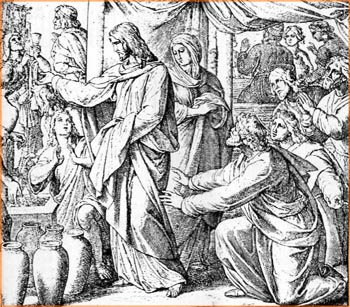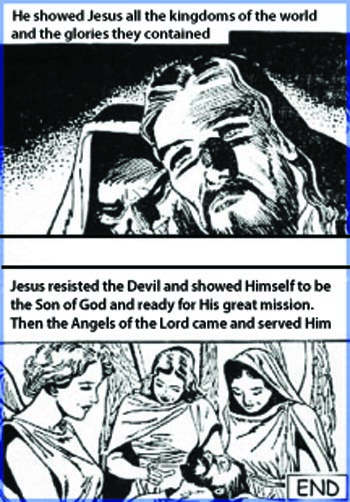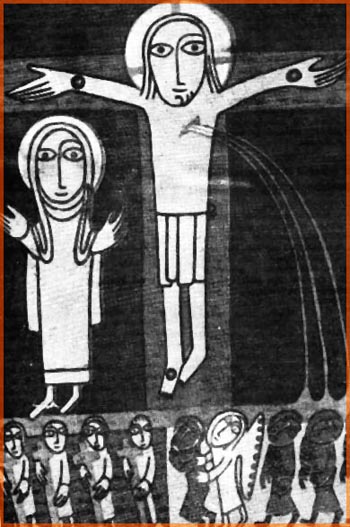Art & Architecture
 |
 |
 |
 |
 |
 |
 |
Theatricality, Romanticism & Hedonism
in Catechism Art
The topic today is complex. It considers catechism illustrations in three different stages with increasing deviations, each worse than the other. The era of the opera exercised its sentimental influence in the first illustration. The cinema era stamped with its worst marks the "comic" genre that inspired the second. The third is a scandal in the fullest sense of the word, having all the symptoms of the defects and degeneration of modern art.
It would be interesting to describe and analyze in depth the link between these deviations, but the nature of this section does not permit this. We will content ourselves, therefore, with some comments.
First, let us note that from 1930 to now (1957), there has also been much positive work in the catechetical field, a fact we do not deny. We simply want to warn our readers here against deviations in the sphere of illustration that we think are particularly dangerous.
*
 Jesus turns water into wine at the wedding of Cana. An 1930 illustration of the biblical story. None of the grand gusts of Christian art blow through this diluted composition. The Blessed Virgin has just obtained an immense grace from Jesus Who, anticipating His series of miracles, worked this marvel at her bequest.
Jesus turns water into wine at the wedding of Cana. An 1930 illustration of the biblical story. None of the grand gusts of Christian art blow through this diluted composition. The Blessed Virgin has just obtained an immense grace from Jesus Who, anticipating His series of miracles, worked this marvel at her bequest.
In this situation, the artist imagines the Virgin with saccharine, cold and indolent physiognamy, a china doll. Our Lord appears as a somewhat languid and dreamy youth who casually receives the proofs of admiration from the bystanders. The theatrical poses of the Apostles makes one smile.
The whole atmosphere is impregnated with a type of sentimentality. One sees that the artist wanted to represent Our Lord and His Blessed Mother as modest and good despite the immensity of the triumph, the Apostles as edifiably enthused, and the wedding banquet crowded and lively. But he lacked any inspiration. The picture is artificial and lifeless. A certain romanticism marks several of its aspects.
Notwithstanding, the intention was good. The author did his best to give a beautiful, pious and worthy idea of the Gospel scene. And, despite the reality of its lack of success, one cannot say that the result was grotesque or ludicrous.
*
 The scene of a biblical story of 1954, presented in "comics" style.
The scene of a biblical story of 1954, presented in "comics" style.
The level fell in every sense: "artistic" (we place the word in quotes because it is hardly art), graphics, psychological. The scenes present a cinematic-romantic conception of the temptation of Our Lord in the desert. Or rather, the conception of a “comic book” history, a deplorable subproduct of the "Hollywood" style.
The position of the head, the vacant, dreamy gaze saturated with a sentimental melancholy, a certain romantic genre of chiaroscuro come together in this figure, who has all the attributes of a movie heartthrob. The frame could be titled ‘Beau Geste wandering in the desert far from home.’
After our star has passed through the trial, we have the happy ending and ‘the girls.’ Jesus conquered the temptation, and the angels come to serve Him. But what Angels ! Female faces and bodies. Their arms bared. The only angelic thing is the wings.
We prefer not to mention the magazine where these sad things were found. We emphasize only that they were made to instill in children a sense of the Gospel. Probably to please them, the scene was stylized in the “comic book” style. And, as always happens in such conceptions, the Gospel is only in the title. The rest is pure "comics." In relation to the previous scene, the fall is considerable...
*
 Now another tumble. And what a fall! This is an illustration from the Offertory of the “Missal of Frère Yves," for children age 7-12. In a statement released by the French press, the National Center for Religious Education in that country announced that " Vatican authorities see in these missals an art to be rejected absolutely because it favors the formation of wrong or unworthy concepts about holy things, especially in the imaginations of children."
Now another tumble. And what a fall! This is an illustration from the Offertory of the “Missal of Frère Yves," for children age 7-12. In a statement released by the French press, the National Center for Religious Education in that country announced that " Vatican authorities see in these missals an art to be rejected absolutely because it favors the formation of wrong or unworthy concepts about holy things, especially in the imaginations of children."
The face is asymmetrical. Only the left eye is garnished with an eyebrow. Only the left side of the nose has a nostril; only on the left side of the chin does one find a few hairs of beard. A beard that one would better call a goatee, with its extravagant and ridiculous curls that rise upward instead of down. A few limp hairs on the head, without grace or nobility, that look like three strands of wire. Arms that one could call cylindrical tubes. Small palms completely out of proportion to the long fingers. A formless body, legs of unequal length. Everything in the end characterizes a fundamentally poorly constructed being.
It is worth noting the presence of a method in this deformity. It essentially consists of a certain organic misery, whereby the body lacked the strength to grow and form itself properly. It is, one would say, more of a draft of a body than a body. Further, an awkward draft. A hand inserted on an arm that is then stuck on a trunk, the absence of elbows and knees, give the impression of a stiff being, ridiculous movements.
All this at the service – or disservice – of a weak mind that looks pathetically (the only word to describe it) at the world with the serenity and lack of concern of one who lacks the discernment to even perceive his own deformity, or the clash between his own figure and the composure, harmony and dignity of nature and the universe.
The nails on the wrist, which look like a type of jacket button, were designed by a person who has ridiculous ideas on such matters. Such foolish ideas, moreover, that while one foot is nailed, the other bobs aimlessly in the air. The wound on the side squirts out three strings of blood, like what a grammar school boy would draw. It appears that the artist is as foolish as the model. One is tempted to title the picture "Self-portrait."
And this would perfectly explain the other figure above. It would be a feminine version of the artist’s own personality.

It would be interesting to describe and analyze in depth the link between these deviations, but the nature of this section does not permit this. We will content ourselves, therefore, with some comments.
First, let us note that from 1930 to now (1957), there has also been much positive work in the catechetical field, a fact we do not deny. We simply want to warn our readers here against deviations in the sphere of illustration that we think are particularly dangerous.

In this situation, the artist imagines the Virgin with saccharine, cold and indolent physiognamy, a china doll. Our Lord appears as a somewhat languid and dreamy youth who casually receives the proofs of admiration from the bystanders. The theatrical poses of the Apostles makes one smile.
The whole atmosphere is impregnated with a type of sentimentality. One sees that the artist wanted to represent Our Lord and His Blessed Mother as modest and good despite the immensity of the triumph, the Apostles as edifiably enthused, and the wedding banquet crowded and lively. But he lacked any inspiration. The picture is artificial and lifeless. A certain romanticism marks several of its aspects.
Notwithstanding, the intention was good. The author did his best to give a beautiful, pious and worthy idea of the Gospel scene. And, despite the reality of its lack of success, one cannot say that the result was grotesque or ludicrous.

The level fell in every sense: "artistic" (we place the word in quotes because it is hardly art), graphics, psychological. The scenes present a cinematic-romantic conception of the temptation of Our Lord in the desert. Or rather, the conception of a “comic book” history, a deplorable subproduct of the "Hollywood" style.
The position of the head, the vacant, dreamy gaze saturated with a sentimental melancholy, a certain romantic genre of chiaroscuro come together in this figure, who has all the attributes of a movie heartthrob. The frame could be titled ‘Beau Geste wandering in the desert far from home.’
After our star has passed through the trial, we have the happy ending and ‘the girls.’ Jesus conquered the temptation, and the angels come to serve Him. But what Angels ! Female faces and bodies. Their arms bared. The only angelic thing is the wings.
We prefer not to mention the magazine where these sad things were found. We emphasize only that they were made to instill in children a sense of the Gospel. Probably to please them, the scene was stylized in the “comic book” style. And, as always happens in such conceptions, the Gospel is only in the title. The rest is pure "comics." In relation to the previous scene, the fall is considerable...

The face is asymmetrical. Only the left eye is garnished with an eyebrow. Only the left side of the nose has a nostril; only on the left side of the chin does one find a few hairs of beard. A beard that one would better call a goatee, with its extravagant and ridiculous curls that rise upward instead of down. A few limp hairs on the head, without grace or nobility, that look like three strands of wire. Arms that one could call cylindrical tubes. Small palms completely out of proportion to the long fingers. A formless body, legs of unequal length. Everything in the end characterizes a fundamentally poorly constructed being.
It is worth noting the presence of a method in this deformity. It essentially consists of a certain organic misery, whereby the body lacked the strength to grow and form itself properly. It is, one would say, more of a draft of a body than a body. Further, an awkward draft. A hand inserted on an arm that is then stuck on a trunk, the absence of elbows and knees, give the impression of a stiff being, ridiculous movements.
All this at the service – or disservice – of a weak mind that looks pathetically (the only word to describe it) at the world with the serenity and lack of concern of one who lacks the discernment to even perceive his own deformity, or the clash between his own figure and the composure, harmony and dignity of nature and the universe.
The nails on the wrist, which look like a type of jacket button, were designed by a person who has ridiculous ideas on such matters. Such foolish ideas, moreover, that while one foot is nailed, the other bobs aimlessly in the air. The wound on the side squirts out three strings of blood, like what a grammar school boy would draw. It appears that the artist is as foolish as the model. One is tempted to title the picture "Self-portrait."
And this would perfectly explain the other figure above. It would be a feminine version of the artist’s own personality.

Catolicismo n. 79, July 1957
Posted October 22, 2014
Posted October 22, 2014
______________________
______________________



